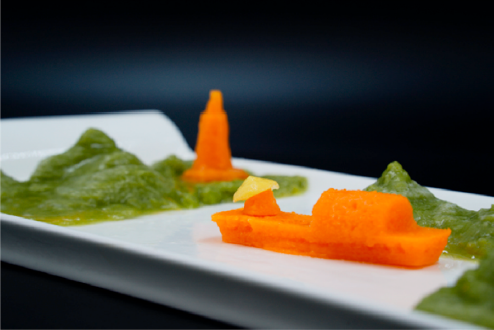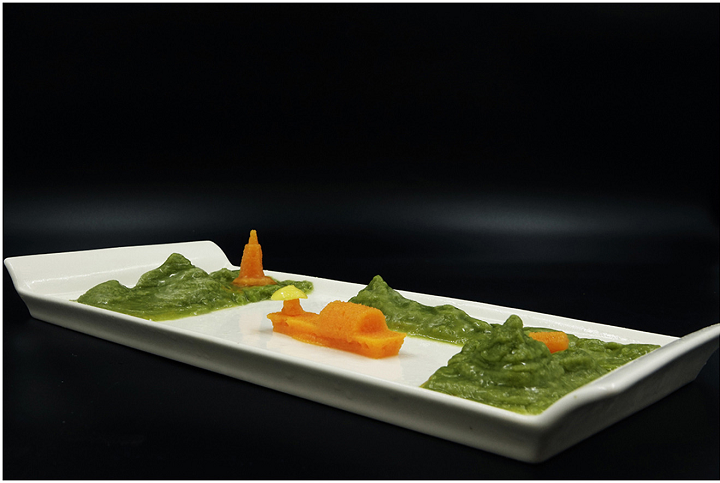3D printing has been used in the past to help elderly patients with dysphagia—difficulty swallowing or chewing—by creating inks made from puréed food and extruding them into a shape that resembles the real dish, like carrots or chicken, to make it more visually appealing. However, while the benefits include a shorter time to fabricate foods in a more appetizing texture and shape, these freeze-dried powders and dehydrated food inks often need to be stabilized with a lot of food additives, like hydrocolloids (HCs), to ensure a smooth print process. This can change the aroma, taste, and texture of 3D printed food, which makes it much less appetizing to dysphagia patients, as you can imagine, and can lead to issues like malnutrition.
A team of researchers from Nanyang Technological University, Singapore (NTU Singapore), Singapore University of Technology and Design (SUTD), and Khoo Teck Puat Hospital (KTPH) published a study, “3D food printing of fresh vegetables using food hydrocolloids for dysphagic patients,” about their work developing a better way to create food inks out of fresh and frozen vegetables so both the flavor and the nutrition are there in the 3D food printing (3DFP) results.
 A ‘foodscape’ assembled with 3D printed designs made from garden peas, carrots and corn.
A ‘foodscape’ assembled with 3D printed designs made from garden peas, carrots and corn.The abstract states, “Dysphagic diets require textural modifications to render them soft and safe to swallow. Diets must be visually pleasing to enable a greater food uptake to prevent malnutrition in patients. 3DFP so far has mainly utilized freeze-dried vegetable powders for shaping 3D designs. Our work focuses on fresh and frozen vegetables having better nutritional profile and low costs. Three different categories of vegetables are identified based on the number of hydrocolloids required to render them printable. Garden pea, carrot and bok choy are chosen as representatives in each category, which requires no HC, one type of HC and two types of HCs, respectively. Food inks are prepared by the addition of HCs i.e. xanthan gum (XG), kappa carrageenan (KC) and locust bean gum (LBG) for texture modification. Rheological, textural, microstructural and syneresis properties of the inks are examined. International dysphagia diet standardisation initiative (IDDSI) tests are done to assess the potential of the inks for dysphagic diets. Optimized ink formulations display excellent 3D printability, minimal water seepage, and dense microstructures with minimal amount of HCs. Using fresh vegetables instead of freeze-dried foods serves the purpose of preserving flavour and nutrition like real food. This in turn may bring 3DFP closer to the hospital and nursing home kitchens.”
In order to make the food inks more stable, the team experimented with different combinations of both fresh and frozen vegetables, and found that they could classify the veggies into one of three categories, each of which requires a different amount of hydrocolloids to be turned into a 3D printable food ink. For instance, the researchers determined that garden pea, carrot, and bok choy would be the representatives of each category, requiring, respectively, no HCs, just one type of NC, and two types of HCs.
“3D Food Printing is more than a novelty. I believe it will be a viable approach in the near future in providing sustenance and nourishment to our increasing ageing population,” stated Gladys Wong, co-principal investigator and Senior Principal Dietitian from KTPH. “Our frail, elderly patients as well as those with swallowing difficulties will be able to enjoy a visually presentable and pleasurable dining experience even with a restrictive diet of smooth pureed dishes.”
 Representative images of 3D printed shapes with five formulations of one food ink type, images with box drawn around them represent the optimised formulations of the inks. Print scores represented on top right corner assessed by shape fidelity and shape stability.
Representative images of 3D printed shapes with five formulations of one food ink type, images with box drawn around them represent the optimised formulations of the inks. Print scores represented on top right corner assessed by shape fidelity and shape stability.Through their research, the team was able to make the 3D printed vegetables more appetizing, as well as preserve the nutrition of the food. In doing so, it seems likely that elderly dysphagic patients will increase their meal consumption, which will enhance both their physical and mental health.
“Our technology helps to provide dysphagic patients with adequate nutrient-rich and safe diets. Their feeding is more dignified, enabling them to socialise and consume meals that look, feel and taste like regular food,” explained Assistant Professor Yi Zhang, the principal investigator from the NTU team. “Our method of 3D printing fresh vegetables can be used easily in hospitals, nursing homes, day care centres for the ageing population with dysphagia and other swallowing disorders. Our research is also another step forward in digital gastronomy, where we can cater to specific requirements prescribed by dieticians, such as nutrition customisation and visual appeal.”
In their research paper, the team also provided an extensive characterization of the properties of various food inks and how suitable they are for patients with dysphagia.
“The next frontier of additive manufacturing is 3D food printing. As the 3D food printing landscape is increasingly evolving, we are excited to continue pushing the boundaries of this industry to find innovative solutions for global issues such as food security and sustainability,” concluded Prof Chua Chee Kai, corresponding author and the Head of Pillar, Engineering Product Development at SUTD.
Subscribe to Our Email Newsletter
Stay up-to-date on all the latest news from the 3D printing industry and receive information and offers from third party vendors.
You May Also Like
World’s Largest Polymer 3D Printer Unveiled by UMaine: Houses, Tools, Boats to Come
The University of Maine has once again broken its own record by unveiling the largest polymer 3D printer in the world. Surpassing its 2019 achievement, the new Factory of the...
Changing the Landscape: 1Print Co-Founder Adam Friedman on His Unique Approach to 3D Printed Construction
Additive construction (AC) is much more versatile than it seems, at first: as natural as it is to focus on the exciting prospect of automated home construction, there’s far more...
Gorilla Sports GE’s First 3D Printed Titanium Cast
How do you help a gorilla with a broken arm? Sounds like the start of a bad joke a zookeeper might tell, but it’s an actual dilemma recently faced by...
3D Printing Webinar and Event Roundup: April 21, 2024
It’s another busy week of webinars and events, starting with Hannover Messe in Germany and continuing with Metalcasting Congress, Chinaplas, TechBlick’s Innovation Festival, and more. Stratasys continues its advanced training...






























